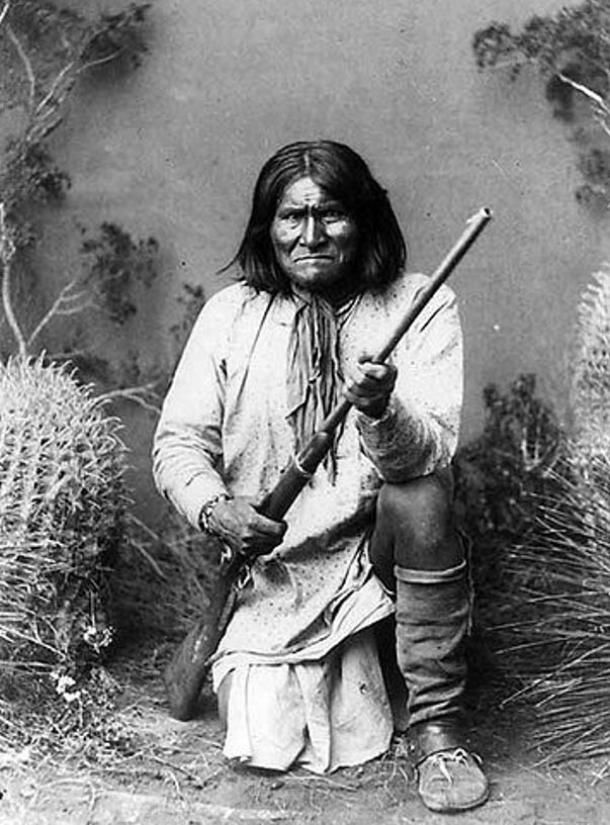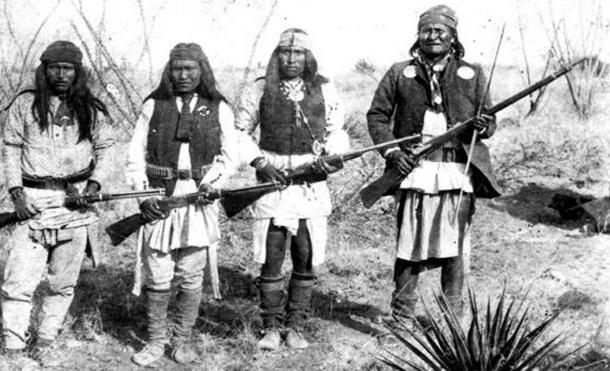Geronimo: The Apache Warrior that fought to Avenge the Slaughter of his Family
GeronimoApacheGuerrilla warfareSecret society(Read the article on one page)In the 1940s, the U.S. Army was experimenting with the possibility of infiltrating enemy territory by dropping soldiers with parachutes from aeroplanes. According to one account, on the night before the first mass jump was to be performed, the soldiers involved were watching the 1939 film Geronimo. After the film, a private by the name of Aubrey Eberhardt boasted that he will shout ‘Geronimo!’ as he jumped out of the plane in order to prove that he was not afraid. This caught on with the rest of Eberhardt’s fellow soldiers, and subsequently the general public. It has since often been mimicked by those preparing to jump from great heights. Who was Geronimo?

Geronimo (Goyathlay, 1820–1909), a Chiricahua Apach ( Wikimedia Commons )
Using guerrilla tactics, Geronimo began conducting daring raids
against the Mexicans. Geronimo’s fearlessness and aggressiveness soon
made him a feared warrior amongst the Mexicans. According to legend, the
terrified Mexican soldiers who had the misfortune of facing Geronimo in
battle would shout and plea to St. Jerome for help and deliverance. As a
result, the man called Goyathlay became known to his enemies as
Geronimo. 
Feared warrior Geronimo (right) and his warriors
from left to right: Yanozha (Geronimos’s brother-in-law), Chappo
(Geronimo´s son of 2nd wife) and Fun (Yanozha’s halfbrother) in 1886 ( Wikimedia Commons )
DiscoverGila WildernessAmerican Indian WarsApache WarriorFreedom of movement
By the middle of the 19 th century, the Mexicans had ceded
large portions of the Southwest to the United States. This change of
hands, however, meant nothing to Geronimo and his followers. The way of
life of these new settlers was opposed to that of the Apache. Apart from
disrupting the Apache’s established way of life, the American settlers
also set limits on the places where they could live, thus restricting
their freedom of movement. When Geronimo’s tribe was removed in 1876 to
the San Carlos Reservation in eastern Arizona, the warrior fled with a
handful of men into Mexico. He was soon arrested in the following year
and brought back. 
Geronimo as a U.S. prisoner ( Wikimedia Commons )
Geronimo escaped again in 1881, and for the next five years waged
what was to become the last of the Indian Wars against the United
States. Geronimo finally surrendered in 1886 to General Nelson Miles, on
the condition that his followers would be allowed to disband and return
home to their families. The United States, however, reneged on its
promise, and sent the men to Fort Pickers, whilst the accompanying women
and children were sent to Fort Marion. Geronimo was later transferred
to Fort Sill, where he became a local celebrity. Among other things,
Geronimo charged visitors to Fort Sill to have their photos taken with
him, took part in Buffalo Bill Cody’s Wild West Circus, was a huge
attraction at the 1904 World’s Fair in St. Louis, and rode in President
Theodore Roosevelt’s inaugural parade in 1905. 
Portrait of Geronimo in 1905 ( Wikimedia Commons )
Despite this fame, Geronimo was still a prisoner of war, even until
his death from pneumonia in 1909. He was never allowed to return to his
homeland, and was buried in a cemetery in Fort Sill. One of the most
bizarre episodes happens to Geronimo’s remains years later. It has been
alleged that the skull and femurs of Geronimo were removed from his
grave, and are now in the possession of a secret society known as the
Skull and Bones Society, an organization of privileged Yale students
whose alumni include Prescott Bush (the grandfather of George W. Bush)
and John Kerry. It is not clear whether the society really have the
skull and femurs of Geronimo. Nevertheless, in 2009, 20 descendants of
Geronimo filed a lawsuit against the secret society seeking to
repatriate their ancestor’s remains and rebury them near his birthplace,
though there has been a lack of hard evidence to support the case.

No comments:
Post a Comment